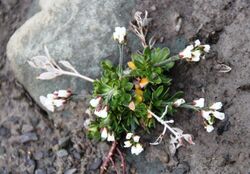Biology:Draba norvegica
| Draba norvegica | |
|---|---|

| |
| Scientific classification | |
| Kingdom: | Plantae |
| Clade: | Tracheophytes |
| Clade: | Angiosperms |
| Clade: | Eudicots |
| Clade: | Rosids |
| Order: | Brassicales |
| Family: | Brassicaceae |
| Genus: | Draba |
| Species: | D. norvegica
|
| Binomial name | |
| Draba norvegica Gunnerus
| |
| Synonyms[1] | |
|
List
| |
Draba norvegica is a species of flowering plant in the mustard family (Brassicaceae) know by the common names Norwegian draba and Norwegian whitlow grass.
Description
Draba norvegica is a small cespitose (forming dense clumps or tufts), herbaceous perennial plant with a rosette of leaves from which a simple unbranched or branched, (0.2-)0.4-1.4(-2) dm tall, flowering stem arises. The basal leaves are simple, with hispid hairs, and narrowly oblanceolate in shape. The stem leaves are also covered in hispid hairs. The flowers are arranged into a raceme inflorescence with 5-23-flowers. The flowers have 2 to 4 rays and are white in color. The fruits (siliques) in contrast to the foliage are hairless or nearly so.[2][3]
Distribution and habitat
Draba norvegica occurs along the Atlantic coast of eastern North America and northwestern Europe with disjunct inland populations. In Canada it is found in arctic and subarctic areas growing on gravelly shorelines, ledges, cliffs, and stone barrens. There is one small population in the USA state of Minnesota found growing on the rocky shores of Susie island in lake superior which has an arctic-like environment.[2] In Minnesota it is listed as an endangered species, with around 50 plants counted in 1998.[4]
References
- ↑ "Draba norvegica Gunnerus". http://www.worldfloraonline.org/taxon/wfo-0000655826#synonyms.
- ↑ 2.0 2.1 Barbara Coffin; Lee Pfannmuller (1988). Minnesota's Endangered Flora and Fauna. U of Minnesota Press. p. 86. ISBN 978-0-8166-1689-3. https://books.google.com/books?id=wfWNq91AjeoC.
- ↑ "Draba norvegica in Flora of North America @ efloras.org". http://www.efloras.org/florataxon.aspx?flora_id=1&taxon_id=250094695.
- ↑ "Draba norvegica : Norwegian Whitlow Grass | Rare Species Guide" (in en). https://www.dnr.state.mn.us/rsg/profile.html?action=elementDetail&selectedElement=PDBRA111N0.
Wikidata ☰ Q1841181 entry
 |

